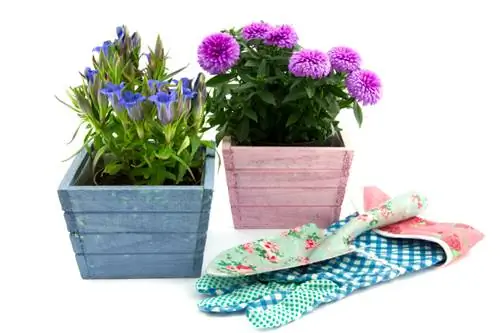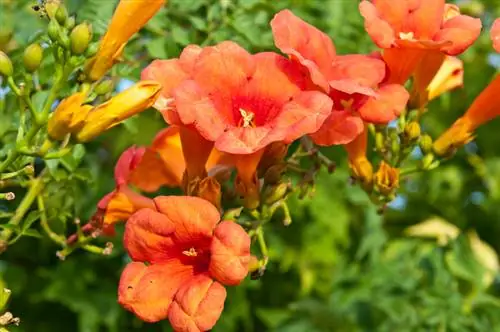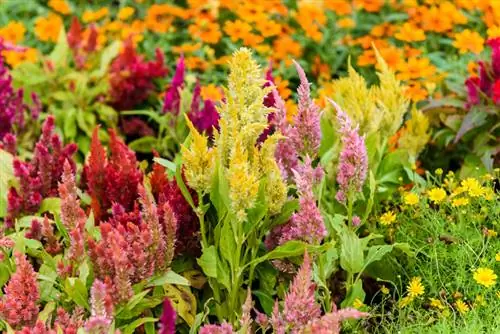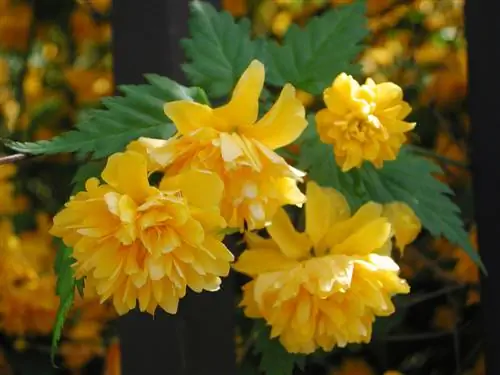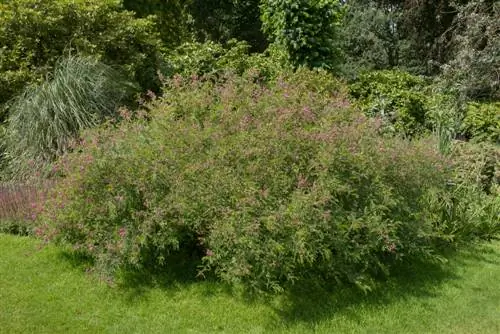- Author admin [email protected].
- Public 2023-12-25 17:45.
- Last modified 2025-01-23 11:22.
Cultivated as a standard tree or shrub, the gentian tree attracts everyone's attention. Coaxing tireless blooms from the capricious ornamental tree is considered an accolade among hobby gardeners. Here, tried-and-tested answers to previously unanswered questions pave the way to a lushly flowering potted plant.

How do I properly care for a gentian bush?
The gentian bush is a demanding ornamental tree that blooms profusely in summer if it is watered daily, fertilized regularly and placed in full sun. Overwinter the gentian bush at 7-12 degrees Celsius and cut it back carefully.
Planting the gentian bush correctly
Plant a gentian tree that you have purchased or that you have grown yourself in a large pot. The cold-sensitive ornamental tree is not suitable for cultivation in beds in the local climate.
- Spread some pottery shards over the water drain as drainage
- Place the potted gentian bush in high-quality pot plant soil (€18.00 on Amazon)
- Leave a watering edge of 2-3 centimeters and water abundantly
Care tips
The demanding gentian tree demands daily attention, which is rewarded with a spectacular blossom festival throughout the summer. The care program in brief:
- Keep the substrate constantly moist
- Watering with soft rainwater or decalcified tap water
- Fertilize liquid once or twice every week from March to September
- Cut cautiously as a standard tree, even during the flowering period
- Clean out wilted flowers to make room for new buds
- Central pruning before clearing or in early spring
A bright, cool winter at 7-12 degrees Celsius is of utmost relevance for flowering. Don't let the soil dry out and stop adding fertilizer from October to February.
Which location is suitable?
You can only enjoy the tireless flowering in a full sun, wind-protected location. If shadow falls on the trunk due to the dense flowers and leaves, this circumstance does not have a negative effect on growth.
What soil does the plant need?
The capricious gentian tree requires a soil that meets the high demands. Therefore, do not buy the first potting soil you come across, but choose a substrate with these attributes:
- Rich in nutrients
- Structurally stable with first-class water storage
- Loose and humorous
- Neutral pH between 6 and 7
Avoid a high proportion of peat as this material tends to compact. Instead, enrich commercial pot plant soil with compost and lava granules.
When is flowering time?
It is not least the never-ending flowering period with which the gentian tree conquers hearts. The blue, purple or white blooms last from spring to late autumn. Regular cleaning encourages increased flower growth.
Cut the gentian bush correctly
One of the key factors in successful care is professional pruning. The top priority is to exercise restraint when using the scissors. How to keep the gentian tree in shape:
- As a standard tree, shorten a few shoots slightly during the season to preserve the shape
- Cut the branches by a maximum of a third before putting them away
- Alternatively, prune in early spring
The younger a gentian bush, the more cautious the pruning is. In old age, a gentian tree with a strong trunk tolerates more vigorous pruning, although never more than 50 percent.read more
Watering the gentian bush
Adequate water balance requires a high degree of sensitivity. Check the moisture content of the substrate daily - morning and evening in summer - using a thumb test. The earth must not dry out at any time. At the same time, waterlogging means the end of every gentian tree. This is how you handle the sensitive care issue correctly:
- Keep the soil evenly moist
- Use collected rainwater or stale tap water
- Empty the coaster after 10 minutes at the latest
Continue water supply at reduced levels during wintering. The cooler and darker the area, the lower the need for moisture. Furthermore, the top priority is not to allow the substrate to dry out.
Fertilize the gentian bush properly
In order for the feat of tireless flowering to be successful, the gentian tree constantly requires a supply of energy. Therefore, fertilize the ornamental tree once or twice a week from March to September with a high-quality liquid fertilizer for potted plants.
Diseases
As a result of an aphid infestation, sooty mold disease can occur, during which the leaves turn black. As a rule, neglect in care causes he alth problems, such as a lack of water and nutrients or improper pruning.
Pests
If you consider cultivating a gentian tree, arm yourself against the following pests:
- Aphids
- Spider mites
- Whiteflies
Wintering
The gentian tree does not tolerate frost. Therefore, in the fall, carry the bucket to winter quarters with these conditions:
- Bright and frost-free with temperatures of 7 to 12 degrees
- Water less, but don't let it dry out
- Do not fertilize from October to February
If the gentian tree drops all its leaves, there is no reason to panic. In the dark season, the wood compensates for the lack of light.read more
Propagate gentian bush
With every pruning you have vital material in your hands for propagation with cuttings. Every shoot tip with a length of 10-15 centimeters is much too good to be disposed of, because it has the makings of a young gentian tree. Place the lower half of the offshoot in a pot with potting soil, put a transparent hood over it and water from below. This is how it continues:
- Keep constantly moist in a partially shaded, warm window seat
- Air the cover daily to prevent mold from forming
- If the cutting sprouts, the hood can give way
read more
How do I transplant correctly?
Every 2 to 3 years the root ball in the pot reaches its limits and is transplanted. For this measure, reserve a day in early spring after pruning, when the gentian tree is still in its dormant state. Shake off most of the used substrate and pot the gentian tree in fresh soil to the same depth as before.
Is gentian bush poisonous?
The gentian tree belongs to the large nightshade family. This results in a high level of toxicity in all parts. Even minimal skin contact can lead to symptoms of poisoning. Consuming small amounts causes vomiting, stomach cramps, respiratory paralysis and even cardiac arrest. Do not cultivate the gentian tree within the reach of small children and pets. Any gardening activity should be carried out with protective gloves.read more
Gentian bush not blooming
It is not a given that the gentian tree blooms. First and foremost, hobby gardeners struggle with a lack of flowers after the winter break. We have put together the most important triggers for this shortcoming with tips for resolving them here:
- Overwintering too warm: Overwinter gentian tree brightly and coolly at 7 to 12 degrees Celsius
- Pruning too much: cut gentian trees by a maximum of 30 percent in autumn or spring
- Nutrient deficiency: Fertilize at least once a week, ideally twice a week in summer
- Unsuitable location: while the trunk can be in partial shade, the crown requires full sun
- Drought stress: Water regularly, in summer when it is dry in the morning and evening with lime-free water
read more
Yellow leaves
Yellowed leaves on the gentian tree are a symptom of a nutrient deficiency due to irrigation water that contains too much lime. Use only soft water and fertilize at least once a week from March to September.
The most beautiful varieties
- Alba: with its pure white flowers, this gentian tree harmonizes with every plant neighbor
- Variegata: a rarity with white-green variegated foliage and blue flowers
- Royal Robe: magical gentian tree with bright purple flowers


